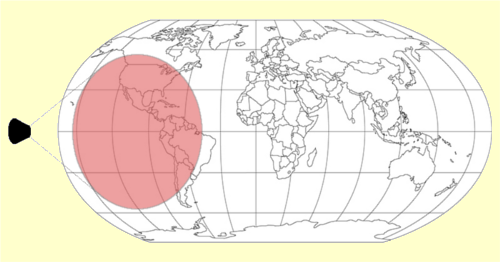The Teleport System
Overview
The world teleport network was an orbital system developed and deployed in the 24th century for the rapid deployment of Special Police and emergency services from orbital space stations to trouble spots on the Earth's surface. The whole system had only 12 orbit-to-ground beams (one housed in each orbiting Watchstation) but due to its rapid switching capability and links between orbital stations and receiving stations on the ground, it was a highly-flexible and versatile system which could be used by multiple teams with very little delay.

Orbital network of teleport stations
Note: there are several examples of short-range personal teleportation systems, either using technological devices or innate super-human abilities. These abilities are outside the scope of this article, which is specifically about the 24th century's orbital teleport network.
History
The orbital Watchstation network was originated in 2320 by the Council of Science, but it was not until the development of the teleport system in 2338 and later improvements by Richard Rogers that the concept really became efficient.
Principles
The teleport system uses a network of 12 space stations equally spaced in geostationary orbit above the Earth's equator. From any given station, the footprint into which a teleport may be made is anywhere between 60 degrees north and 60 degrees south latitudes and within 60 degrees east or west of the point above which the station is orbiting.

60-degree footprint of single teleport station
This allows the network of 12 stations to cover all of the Earth (with considerable overlap) except for the extreme polar regions. For practical purposes, the majority of the inhabited land masses of the 24th century are within teleport reach. Several teleport equipped stations at the same orbital height could teleport between themselves (so long as they were not separated by more than 60 degrees of arc), meaning that items could be transferred around the globe from station to station, and put down at any point, almost instantaneously.
The teleport beam follows a straight line from station to the Earth's surface, and objects can be teleported to any height along that line. As the beam's operation is tied into the Earth's gravitational field it can only be directed Earthwards, not out into space (this limitation was overcome in a later design of the system but was in place in the teleport system fitted to the Strikeforce space station).
The teleport system operates by putting matter partly out of phase with the normal universe. This allows the matter to cross the intervening distance at a velocity of 0.98c, which is instantaneous for all practical purposes. The teleport can operate most effectively with both a transmitting and a receiving terminal, but it can operate with just a single terminal (at either end). The teleport is limited by the density of matter in the teleport path and by gravitational field lines.
The teleport system can transport a maximum of 30 cubic metres at one time. The item(s) to be transported must occupy a cylinder of 2m radius and 4m height, which are the dimensions of the teleport pads on Watchstation space stations. The actual mass to be transported is not a factor.
Although the act of teleporting is almost instantaneous, it takes time to place a beam at precise co-ordinates on the Earth's surface as detailed sensor readings of the intervening medium and complex calculations are required. This delay is typically anything up to thirty seconds and frequently much less. Once placed, the beam can be held steady for as long as required with pin-point accuracy. As soon as the beam is lifted, the whole process must be restarted even if it is replaced in the same position. This problem can be alleviated by having receiving stations (sometimes called "slave" stations) that are constantly actively analysing and recalibrating for local conditions. The teleport may then be directed to the slave's location with no delay. It is this master-slave principle which allows station-to-station teleports, as well as teleports to fixed ground receiving stations (such as Special Police headquarters and other key locations in the 24th century).
Once placed, the beam can be left active or passive. An active beam teleports anything that enters its area (at the specified beam altitude). A passive beam awaits an "on" signal. In either mode, the teleport can have a beam of bright white light heterodyned down it, illuminating any specified portion of the beam. The beam is non-selective within its area. When activated, everything in the beam area at the specified height is teleported together.
The teleport beam will terminate where it encounters anything denser than air. Thus, it will not teleport anything underground or through the ceiling of a building. The exception is where there is a "slave" station, which can be housed inside a building and still connect to the master beam.
The Strikeforce Teleport
The teleport used by Strikeforce in the 20th century is operating under several limitations, primarily due to it being operated from a single Watchstation, without the added sensory power or switching abilities of the complete network.
The Strikeforce teleport was limited to a 60-degree footprint, and to reach a spot outside this footprint required a physical movement of the station around its orbit (something that could be achieved by manipulation of the graviton flywheel).
Typically, it took Strikeforce around ten minutes to place a beam. This made it impossible to use as a tactical combat option (as it would have been in the 24th century) and meant that they had to plan and coordinate their strategic moves to and from the station very carefully. Typically for Strikeforce, this level of planning rarely happened.